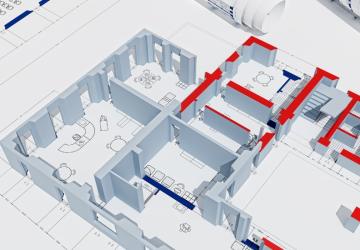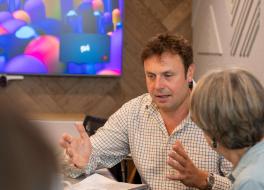
Blog: A positive approach to tech & stammering, with Ocean 3D
Jack, who volunteers for the STAMMA Employment & Training Services, reflects on our fruitful meeting about building in stammering accessibility with a 3D tour company.
This blog is all about how technology can help people who stammer. But allow me to be indulgent and start with just a couple of paragraphs of grumpy negativity!
People with impairments or disabilities often have a marmite relationship with technology. For everyone who benefits hugely from the wonders of modern technology, there are dozens more people who struggle with buildings and services where accessible or inclusive design has not been a real consideration. From signage to seating, from physical access to computer layouts, too many lose the battle with technology on a daily basis.
Recently, this has become increasingly true for people who stammer. Many of us have always regarded the phone as the instrument of the Devil but now the Devil is adding more weapons to his armoury: the intercom you have to navigate before you're allowed into a building or out of a car park, the challenge to get past the GP reception system, the Zoom call; or that special place in hell reserved for voice recognition technology.
It's easy to feel that technology and organisational processes are against people who stammer — and, to be fair, they often are.
It was therefore refreshing and encouraging to meet some technologists recently who put accessibility first and who were keen to understand the challenges that having a stammer can present.
We spoke with Ocean 3D, a West Country-based company that creates interactive virtual tours and maps of buildings. They contacted STAMMA with a sales call and we got talking about the challenges people who stammer sometimes face in new environments. As they endeavour to bake in accessibility to their services from the start, they were really interested to learn more. So, we arranged a meeting to talk about how they can become more accessible for those who stammer.

We met with Chris Wood and Ros Osborne. Chris is ex-military, experienced in legislative compliance, and has personal knowledge of complex PTSD and hidden disabilities. Ros is nationally recognised in the fields of accessibility and SEND (Special Education Needs and Disabilities) provision.
The Ocean 3D mantra is that 'knowledge dispels fear'. They recognise the stress of not knowing what to expect in a new and strange place. And they recognise that, for some people, asking for directions from strangers can be difficult. They believe that their virtual tours can help change that. A young child can sit with their parents and explore a new school on their tablet before their first visit. A student can use their phone to check what to do at a college reception area. A hospital operation in a few days? Sit at the laptop and explore in detail what you need to do and where you need to go.
Applying Ocean 3D's tech to stammering
We covered an invigorating and wide range of topics during our chat with Chris and Ros: What does accessibility really mean? Could journey planning become an anticipatory duty under the Equality Act? (spoiler alert, it already is). Our conversation quickly turned to the speech challenges that people who stammer might unhappily anticipate when planning to visit somewhere for the first time:
- Going through security
- Registering at reception
- Having to ask for directions
- Using an intercom to get into restricted areas
- Having to use a voice-recognition system.
Much of this was new to Ocean 3D but they responded enthusiastically and quickly. They sent out STAMMA's guides to all their clients, while also offering them the opportunity to add free markers to their tours showing where verbal communication is expected. Clicking on a marker can tell you what type of communication it is (face-to-face? Intercom?) and what support is available.
It was great to talk with Ocean 3D and see what can be done, using technology to help, not hinder, people who stammer.
In their blog post about this, titled 'Ocean 3D's commitment to stammer-friendly experiences', they say:
"We recognise that visiting new places can be daunting, especially for individuals who stammer. To ease this, we're encouraging all our clients to include specific information in their tours…This proactive approach empowers both the staff and visitors, ensuring a welcoming environment for everyone."
As part of their mission for a more inclusive and accessible world, Ocean 3D are now explaining to new clients the importance of having these communication information points on their interactive tours.
It's easy to feel that technology and organisational processes are against people who stammer — and, to be fair, they often are. But it is possible to have conversations, create awareness, work with allies and make a difference. It was great to talk with Ocean 3D and see what can be done, using technology to help, not hinder, people who stammer.
You might find it useful to know that some places you visit may already have virtual tours that you can explore. But it's also important for us to consider how we continue such conversations. How do we promote Ocean 3D and others like them as examples of best practice? And how do we call out organisations that fall short? We'll continue to ponder these things within the STAMMA Employment and Training services.
Become a STAMMA member for free or sign up to our newsletter.

































